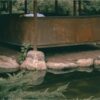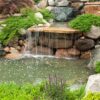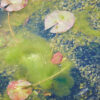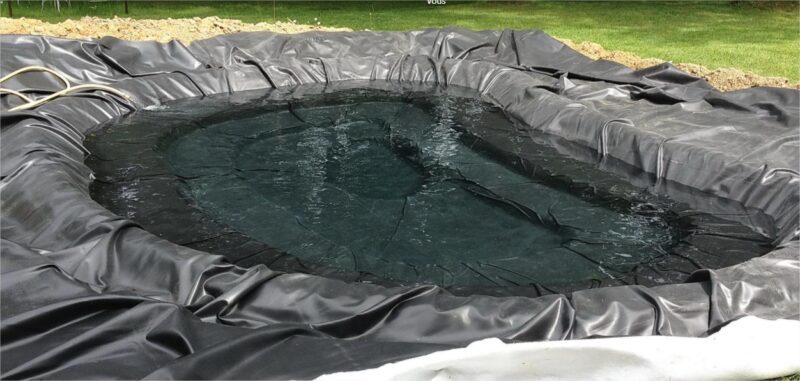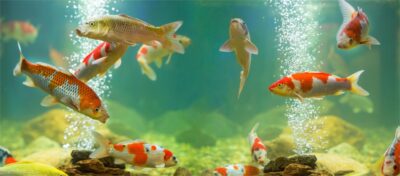Potted aquatic plants often cannot be placed on shelves that are wide enough to hold them. Pond liner allow you to create beautiful streams that flow into ponds.
Koi ponds and water gardens are built and installed to provide a piece of nature in our homes. In your backyard, there’s a good chance you won’t have a pond.
In reality, you must build your own koi ponds or water gardens if you want them. I think that’s great news because most natural ponds aren’t the right size to hold fish and blooming water lilies. Neither are deep enough, shallow enough, wide enough, or small enough to sustain fish and plants.
We build ponds and water gardens in our backyards because we love nature. Our own designs give us control over every aspect of how deep and wide the pool will be, how it will be positioned in our yard, and how long it will be.
It is possible to buy a preformed plastic liner, but they certainly limit your creativity and options. Small sizes and shallow depths are the only available options for pre-formed ponds. For your pond shell not to bow from lack of support, you must dig the hole exactly in the same shape and depth as the plastic shell. Raised plant shelves are commonly included in pre-formed pond liners.
The possibilities are limitless when it comes to creating a pond or water feature! The raised shelves can be placed wherever you want with a flexible pond liner
Pond Liners: What’s the Purpose?
Pond liners are primarily designed to prevent water from leaking from your pond. You do not need a liner for your pond unless you dig it in soil that is extremely clay-rich.
As a consequence, you’d have to regularly top off your pond, which would be time-consuming and would cause major disturbances for your fish and plants.
A pond liner may be worth considering even if you have soil that has a lot of clay. Clay will absorb water, so even after you install a pond, the water will slowly leak out.
Pond liners provide your plants with several benefits beyond simply sealing in water. Depending on the type of lining you use, you may either anchor plants to the liners or layer additional substrate atop them.
Pond Liner Considerations
You have a lot of options when choosing a liner for an existing or newly constructed pond.
Considering the different pond types, different liners, and what makes some types of liners better for certain types of ponds can help you decide which liner would be best suited for your pond.
Choosing between a preformed concrete floor and a flexible floor
Choosing a flexible liner, concrete slab, or preformed liner is your first step.
They are the most affordable and easiest to install types of pond liners. Liner material made from flexible plastic can be cut to any shape and size and can be fitted into any pond’s dimensions.
You can incorporate one into your yard’s landscape or give it an unusual shape, which is a major advantage. Additionally, flexible pond liners can easily be modified later if your pond needs to be expanded or contracted.
The most difficult liners to make are flexible liners. Ensure that your liner covers the entire pond by measuring and cutting it carefully. Your pond might need filling in or starting over if the water isn’t enough.
Different Materials: Their Advantages & Disadvantages
You should also think about what type of material the liner is made of if you’re choosing a preformed or flexible liner.
Making a wise decision on your pond liner requires an understanding of the advantages and disadvantages of different materials.
EPDM Liner
Since EPDM is inexpensive and very effective, it is very common for flexible pond liners.
Using EPDM you can create highly custom shapes of ponds by folding it easily around corners.
Furthermore, EPDM sheets can be joined together with liner tape, enabling multiple sheets to be cut for installation.
The advantage of this is that you will be less likely to make mistakes when measuring your cuts, as well as the simple ability to add more EPDM sheets to your existing pond lining.
EPDM has several disadvantages, including its relatively heavyweight and its relatively low puncture resistance compared to other flexible liners.
Since EPDM sheets can be difficult to ship directly to your home due to these concerns, ponds lined with EPDM liners usually require an underlay.
PVC Liner
If you are looking for flexible pond liners, PVC liners are the most affordable option.
As compared to EPDM liners, the liners are not quite as heavy, and they offer slightly better puncture resistance. Additionally, PVC liners can be easily shaped to fit the shape of your pond using lining tape, making them a relatively flexible option.
It is not uncommon to find PVC pond liners in ponds, but there are some disadvantages to using them. As a result of the manufacturing process, PVC pond liners often contain highly toxic trace levels of arsenic and other chemicals that could harm fish.
A foot or more of soil will be necessary to protect the PVC from dry weather or direct sunlight. Finally, PVC is prone to cracking if it is exposed to cold weather or direct sunlight. In the event that the liner cracks, water could leak into the soil and become stagnant.
HDPE Liner
The best choice for pond liners is high density polyethylene, commonly known as HDPE or reinforced polyethylene.
While being one-third the weight and half as thick as EPDM or PVC, they are even more puncture resistant. So ponds of any shape can be shipped, installed, and conformed to the shape of your pond.
Heat guns can also be used to join HDPE sheets, which is a more stable method than liner tape.
Additionally, HDPE liners are typically so rigid that built-in underlays for ponds aren’t necessary. If you take proper care of HDPE, you won’t have to replace your liner once your pond is constructed.
One apparent disadvantage is the higher price of HDPE liners relative to EPDM and PVC pond liners. Nevertheless, the extra cost is well worth it if you plan on keeping your pond for years or plan to upgrade from a preformed liner.
Rubber Liner (Butyl Rubber)
Because multiple sheets of butyl rubber can be welded together with heat, it is widely used in preformed and flexible liners.
Those looking for flexible sheets often prefer butyl rubber liners due to their puncture resistance and lower cost than EPDM liners. Although butyl rubber is not able to stretch, small sheets can be welded together to create any shape you desire.
There are generally only a few shapes available for preformed butyl rubber liners. Butyl rubber sheets can nevertheless be heat welded onto preformed liners to create a customized liner design if you know how to do this.
Fiberglass Liner
Because of its incredible strength, fibreglass is frequently used for preformed pond liners. The fiberglass liner does not need to be supported by soil surrounding it when it is preformed.
As a raised pond, the fiberglass liner could even be placed above ground and then surrounded with dirt and rock.
Furthermore, fiberglass is extremely durable, which makes it a powerful material.
As opposed to rubber and plastic, glass won’t crack or leak at high or low temperatures or when exposed to direct sunlight. During the winter, even if your pond is covered with ice, fiberglass will flex somewhat.
Concrete Floor
The standard material for pond building is concrete. Concrete is an excellent material for ponds that are built to last for many years to come. Concrete is a very durable material. Nowadays, preformed and flexible liners are more popular as they are more durable (especially with regard to comfort). It is by far the most difficult to install a concrete pond. The work is hard and backbreaking, requiring more than simple skill. Liners of this type are also among the most expensive. Additionally, it must be thoroughly treated to ensure that none of the lime in the concrete leaches into the water, which will cause a catastrophic swing in pH. This is certainly not a simple task to undertake.
Since ancient times, concrete has been used for pond linings as it is one of the most durable materials available. No matter what the weather conditions are, it won’t crack and is almost impossible to puncture.
As a result, concrete is usually used for very large or deep ponds that require lots of liners.
The concrete pond has largely fallen out of favor due to its high price, lengthy pouring procedure, and difficulty in properly assembling it. However, a concrete pond can last a generation if it is well constructed. This is because concrete is still more durable than other pond liners. The use of concrete can be a great choice if the budget is not an issue or if the pond is very large. You should make sure that the pond builder you choose has extensive experience creating concrete ponds. Concrete ponds have become rarer as the pond building industry has grown, so few builders have experience with them. Concrete ponds are still available (usually from older companies) in most areas, but they tend to be quite expensive.
Type of Pond Liner Based on Weather Conditions
You have to consider your local weather conditions when picking the right type of pond liner material.
Other materials, however, are more likely to crack or wear out after years of exposure to inclement weather. Some rubber liners are virtually impervious to all temperatures and conditions, whereas other materials are more vulnerable to cracking and wear.
Your first consideration should be how cold it gets in your winters. The liner of your pond needs to withstand sub-zero temperatures so that it doesn’t freeze and crack.
PVC and butyl rubber liners are susceptible to cracking in very cold temperatures, while EPDM and HDPE liners can withstand negative temperatures.
The fiberglass liners that you can purchase for use in preformed ponds can expand a little bit to accommodate the increased volume if your pond freezes.
The amount of sun your pond receives is another factor to consider. PVC and butyl rubber are susceptible to cracking over time when exposed to UV light.
Despite the relatively high resistance of products such as EPDM, HDPE, and fiberglass to UV light, even these materials will wear out with time when directly exposed to sunlight. In the presence of prolonged direct UV exposure, only concrete is completely immune to its effects


